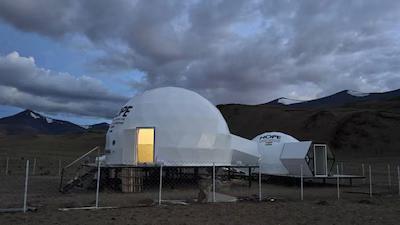
ISRO Sets Up Station in Ladakh to Simulate Life on Moon & Mars
The Indian Space Research Organisation (ISRO) has taken a significant step towards understanding the challenges of sending humans to the Moon and Mars by setting up a unique simulation station in Ladakh’s Tso Kar Valley. The Himalayan Outpost for Planetary Exploration (HOPE) is designed to test life-support systems for lunar and Martian missions, and two crew members will undertake various tests at the facility from August 1-10.
The valley was chosen for its unique environment, which mimics the harsh conditions found on Mars. The high UV radiation, low atmospheric pressure, extreme cold, and saline permafrost in the region make it an ideal location to simulate the conditions that astronauts will face on future missions to the Red Planet.
The HOPE station is a miniaturized version of the habitat that will be used on future lunar and Martian missions. It is designed to sustain human life for extended periods in extreme environments, with all the necessary systems for air, water, and food production, as well as waste management and recycling.
The 10-day simulation mission, which began on August 1, will see two crew members living in the HOPE station and performing various tests to evaluate the effectiveness of the life-support systems. The crew will be tasked with monitoring and maintaining the station’s systems, as well as conducting scientific experiments to gather data on the effects of the extreme environment on the human body.
The HOPE station is equipped with state-of-the-art facilities, including a life-support system, a water recycling system, and a food production system. The station is also equipped with advanced scientific instruments, including sensors and cameras, to monitor the environment and collect data.
The simulation mission is an important step towards India’s plans to send humans to the Moon and Mars in the future. ISRO has already successfully launched several unmanned missions to the Moon and Mars, but sending humans to these destinations requires a much more complex and challenging endeavour.
The HOPE station is designed to provide a safe and reliable environment for astronauts to live and work in for extended periods. The mission will help scientists and engineers to identify and overcome the challenges of long-duration spaceflight, and to develop the necessary technologies and systems to support future human missions to the Moon and Mars.
The simulation mission is also an important step towards India’s plans to establish a human settlement on the Moon in the near future. The Indian government has announced plans to send a human mission to the Moon by 2024, and the HOPE station is a key part of these plans.
The HOPE station is not the first time that India has used Ladakh as a location for space-related activities. In 2019, ISRO conducted a rocket test in the region, which was part of a larger effort to develop India’s capabilities for launching heavy-lift rockets.
The Himalayan Outpost for Planetary Exploration is an important step towards India’s ambitious plans for space exploration. The simulation mission will provide valuable data and insights that will help scientists and engineers to develop the necessary technologies and systems to support future human missions to the Moon and Mars.






